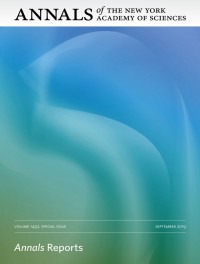Annals of the New York Academy of Sciences Q1 Unclaimed
Annals of the New York Academy of Sciences is an international science journal published bi-monthly as themed special issues in many areas of science, though predominantly the biological sciences. Each of twenty-four annual issues presents Original Research Articles and/or commissioned Review, Commentary, and Perspective Articles. Ann NY Acad Sci is a hybrid journal available in over 80 countries, is rigorously peer-reviewed, and is ranked among the top multidisciplinary journals worldwide. It has an SJR impact factor of 1,458.
Annals of the New York Academy of Sciences focuses its scope in these topics and keywords: effects, cell, brain, cells, human, immune, role, disease, liver, ptsd, ...
Type: Journal
Type of Copyright:
Languages: English
Open Access Policy:
Type of publications:
Publication frecuency: -


3350 €
Inmediate OANPD
Embargoed OA0 €
Non OAMetrics
1,458
SJR Impact factor301
H Index160
Total Docs (Last Year)541
Total Docs (3 years)18109
Total Refs3044
Total Cites (3 years)517
Citable Docs (3 years)5.04
Cites/Doc (2 years)113.18
Ref/DocOther journals with similar parameters
Annual Review of Medicine Q1
Nature Protocols Q1
Annals of the Rheumatic Diseases Q1
Developmental Cell Q1
EMBO Journal Q1
Compare this journals
Aims and Scope
Best articles by citations
CHEMICAL COMPOSITION OF CELL WALLS AND MEMBRANES OF YEASTS
View moreEFFECT OF COMBINED MYCOPLASMA PNEUMONIAE AND PNEUMOCOCCAL INFECTIONS IN HAMSTERS
View moreFish Oil and Tocopherol Induced Changes in ex Vivo Synthesis of Spleen and Lung Leukotriene B4
View moreCD8+T-Cells in Psoriatic Lesions Preferentially Use T-Cell Receptors V?3 and/or V?13.1 Genes
View moreWest Nile Encephalitis in Russia 1999-2001
View moreWest Nile Fever in Israel 1999-2000
View moreA Follow-up Study on Newly Recognized Spotted Fever GroupRickettsiaein Ticks Collected in Southern Croatia
View moreProresorptive Actions of FSH and Bone Loss
View moreEvolutional Analysis in Determining Pathogenic versus Nonpathogenic Mutations of ATPase 6 in Human Mitochondriopathy
View moreWest Nile Virus Envelope Protein
View moreSurveillance of Human Ehrlichiosis in the United States: 1988
View moreProspective Study on Symptomatic versus Asymptomatic Infections and Serological Response to Spotted Fever Group Rickettsiae in Two Rural Sites in the Negev (Southern Israel)
View moreAltered Pattern of Connectivity in Chagas Disease
View moreEPIDEMIOLOGICAL STUDIES OF MYCOPLASMA PNEUMONIAE INFECTIONS IN CIVILIANS
View moreBlood Lipid Peroxides and Muscle Damage Increased following Intensive Resistance Training of Female Weightlifters
View moreIL-5 Inhibits Apoptosis by Upregulation of c-myc Expression in Human Hematopoietic Cells
View moreClass Switching in Human Immunoglobulin Transgenic Mice
View moreCandidatus Rickettsia tarasevichiae' inIxodes persulcatusTicks Collected in Russia
View moreHIV Antibody EIA and Western Blot Assay Results on Paired Serum and Saliva Specimens
View moreReport of Eight Cases of Fatal and Severe Mediterranean Spotted Fever in Portugal
View moreIdentification of Three Mutations in the Cu,Zn-Superoxide Dismutase (Cu,Zn-SOD) Gene with Familial Amyotrophic Lateral Sclerosis: Transduction of Human Cu,Zn-SOD into PC12 Cells by HIV-1 TAT Protein Basic Domain
View moreCulture-Derived Parasites in Vaccination of Cattle against Tick-Borne Diseases
View moreContemporaneous reproduction of preclinical science: a case study of FSH and fat
View moreEnhancing the Sensitivity of Assays to Detect T Cell Reactivity: The Effect of Cell Separation and Cryopreservation Media
View more
Comments